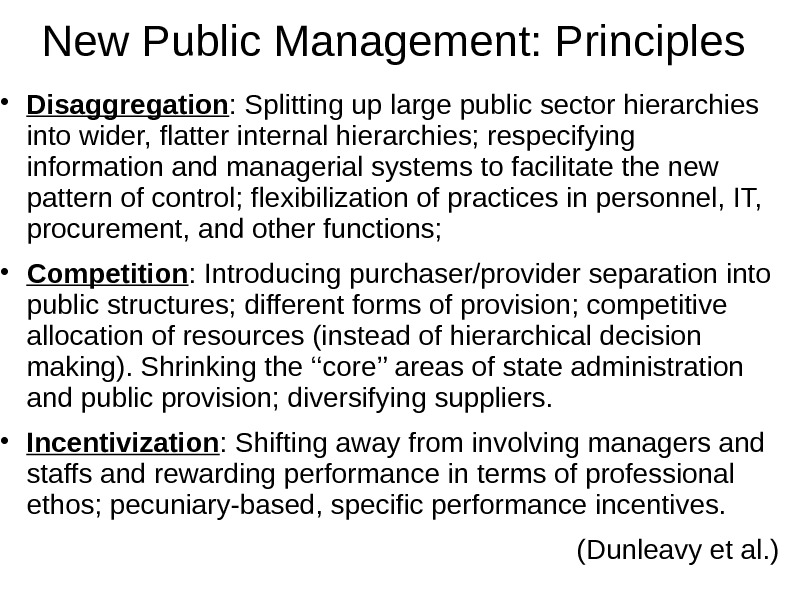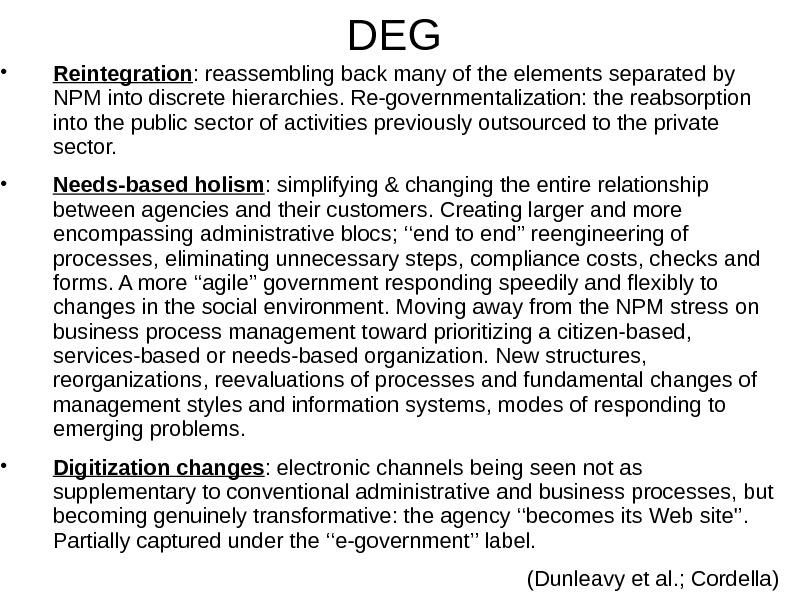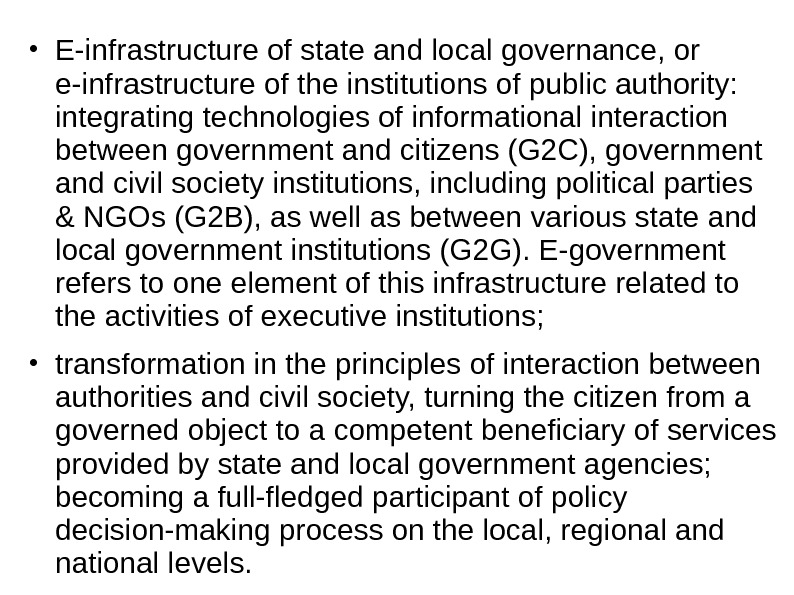New Public Management. Digital Era Governance Principles



















new_public_management_-_digital_era_governance.ppt
- Размер: 322 Кб
- Количество слайдов: 18
Описание презентации New Public Management. Digital Era Governance Principles по слайдам
 New Public Management. Digital Era Governance
New Public Management. Digital Era Governance
 Principles of state bureaucracy • a formal hierarchical structure of authority; • a detailed and rationalised division of labour; • a set of formal, explicit, comprehensive and stable rules; impersonality in exercising functions. (Weber 1947)
Principles of state bureaucracy • a formal hierarchical structure of authority; • a detailed and rationalised division of labour; • a set of formal, explicit, comprehensive and stable rules; impersonality in exercising functions. (Weber 1947)
 New Public Management theory of managerial change: redefine managerial and governance practices in the public sector in line with objectives typical of market economics ( Osborne & Gaebler , 1992); Efficiency : results-driven, well-performing organization seeking productivity; Accountability; Decentralisation of control : “replacing rigid hierarchical organisational structures with dynamic networks of small organisational units; replacing authoritarian, top-down decision and policy-making practices with a more consensual, bottomup approach which facilitates the participation of as many stakeholders as possible, especially ordinary citizens”; Marketisation : alternative service delivery mechanisms, quasi-markets with public and private service providers competing for resources from policy-makers; competition to increase efficiency strong customer orientation in public service provision; internal organizational cultures: more individualistic, less hierarchical control mechanisms; inventions and extensions of policy technologies; ‘ Reinventing Government’: “under great fiscal pressure, public sector organisations introduce market forces into monopolistic government enterprises to survive the reduced access to public resources”; creating a ‘slim State’ with ‘slim Government’ through ‘slim Management’: more transparency & quality, reduction of expenditure. (Pollitt; Aucoin 1996; Pollit and Bouchaert, 2004; Hood 1998; Dunleavy et al. )
New Public Management theory of managerial change: redefine managerial and governance practices in the public sector in line with objectives typical of market economics ( Osborne & Gaebler , 1992); Efficiency : results-driven, well-performing organization seeking productivity; Accountability; Decentralisation of control : “replacing rigid hierarchical organisational structures with dynamic networks of small organisational units; replacing authoritarian, top-down decision and policy-making practices with a more consensual, bottomup approach which facilitates the participation of as many stakeholders as possible, especially ordinary citizens”; Marketisation : alternative service delivery mechanisms, quasi-markets with public and private service providers competing for resources from policy-makers; competition to increase efficiency strong customer orientation in public service provision; internal organizational cultures: more individualistic, less hierarchical control mechanisms; inventions and extensions of policy technologies; ‘ Reinventing Government’: “under great fiscal pressure, public sector organisations introduce market forces into monopolistic government enterprises to survive the reduced access to public resources”; creating a ‘slim State’ with ‘slim Government’ through ‘slim Management’: more transparency & quality, reduction of expenditure. (Pollitt; Aucoin 1996; Pollit and Bouchaert, 2004; Hood 1998; Dunleavy et al. )
 New Public Management: Principles Disaggregation : Splitting up large public sector hierarchies into wider, flatter internal hierarchies; respecifying information and managerial systems to facilitate the new pattern of control; flexibilization of practices in personnel, IT, procurement, and other functions; Competition : Introducing purchaser/provider separation into public structures; different forms of provision; competitive allocation of resources (instead of hierarchical decision making). Shrinking the ‘‘core’’ areas of state administration and public provision; diversifying suppliers. Incentivization : Shifting away from involving managers and staffs and rewarding performance in terms of professional ethos; pecuniary-based, specific performance incentives. (Dunleavy et al. )
New Public Management: Principles Disaggregation : Splitting up large public sector hierarchies into wider, flatter internal hierarchies; respecifying information and managerial systems to facilitate the new pattern of control; flexibilization of practices in personnel, IT, procurement, and other functions; Competition : Introducing purchaser/provider separation into public structures; different forms of provision; competitive allocation of resources (instead of hierarchical decision making). Shrinking the ‘‘core’’ areas of state administration and public provision; diversifying suppliers. Incentivization : Shifting away from involving managers and staffs and rewarding performance in terms of professional ethos; pecuniary-based, specific performance incentives. (Dunleavy et al. )
 Reasons for abandoning NPM increase in institutional and policy complexity: disaggregation and competition increased the numbers of administrative units and created more complex and dynamic interrelationships among them reducing citizens’ autonomous problem-solving capacities: a cost in capacity for collective action, when the public service is differentiated and fragmented; cost reduction leading to “quality-shading”. For customers, the reliability of the service is more important than a small cost reduction; Incentivization -> conflict with public interest ethos (lifelong career paths for civil servants).
Reasons for abandoning NPM increase in institutional and policy complexity: disaggregation and competition increased the numbers of administrative units and created more complex and dynamic interrelationships among them reducing citizens’ autonomous problem-solving capacities: a cost in capacity for collective action, when the public service is differentiated and fragmented; cost reduction leading to “quality-shading”. For customers, the reliability of the service is more important than a small cost reduction; Incentivization -> conflict with public interest ethos (lifelong career paths for civil servants).
 (Dunleavy et al. )
(Dunleavy et al. )
 ICT: levels of citizen-government interaction • Information : posting online the relevant information about the services offered by the public offices. Unidirectional. Description of the services; contact details. • Interaction : facilitating a two-way communication between citizens and the public office; exchange of information. Requires a profound change in the culture, organisation and procedural activities of the public offices. • Processing : tasks, previously carried out by public servants, turn into interaction or webbased self-service ( e. g. , online self-assessment tax system, driver vehicle licensing ); • Transaction : portals for a wide and integrated range of public services. Overcoming limitations of single web pages. An integrated approach towards the provision of government services, based on citizens’ needs, replacing the traditional structure of department or agencies. No need for the users to understand an agency’s structure, government and bureaucratic relationships. (A. Cordella)
ICT: levels of citizen-government interaction • Information : posting online the relevant information about the services offered by the public offices. Unidirectional. Description of the services; contact details. • Interaction : facilitating a two-way communication between citizens and the public office; exchange of information. Requires a profound change in the culture, organisation and procedural activities of the public offices. • Processing : tasks, previously carried out by public servants, turn into interaction or webbased self-service ( e. g. , online self-assessment tax system, driver vehicle licensing ); • Transaction : portals for a wide and integrated range of public services. Overcoming limitations of single web pages. An integrated approach towards the provision of government services, based on citizens’ needs, replacing the traditional structure of department or agencies. No need for the users to understand an agency’s structure, government and bureaucratic relationships. (A. Cordella)
 Digitalization: stage I (before late 90 s) • office automation adapted to the preexisting organizational culture of public sector; • agencies becoming highly dependent on IT infrastructures, without changing their modes of operating; • ministers or senior officials changing policies and then commissioning alterations of IT systems to fit in with the new decisions; • once routinized to the point of being handled automatically, organizational cultures downgrade the importance of functions for managerial performance; • limited transformative impacts; “back-office” processes (Cordella 2007). • lower transactions costs, improved efficiency, new strategic and operational possibilities: customer-oriented services (Fountain, 2001)
Digitalization: stage I (before late 90 s) • office automation adapted to the preexisting organizational culture of public sector; • agencies becoming highly dependent on IT infrastructures, without changing their modes of operating; • ministers or senior officials changing policies and then commissioning alterations of IT systems to fit in with the new decisions; • once routinized to the point of being handled automatically, organizational cultures downgrade the importance of functions for managerial performance; • limited transformative impacts; “back-office” processes (Cordella 2007). • lower transactions costs, improved efficiency, new strategic and operational possibilities: customer-oriented services (Fountain, 2001)
 Stage 2: Digital Era Governance • Internet, e-mail, and the Web and the generalization of IT systems conditioning overall relations between government agencies and civil society; • new information-handling potentialities; transition to fully digital modes of operating; • complex IT-based changes spreading much more widely and simultaneously in multiple dimensions; • general, pervasive and structural influence on changing governance arrangements; • IT changes working through indirectly: • organizational and organizational culture changes inside the government sector; • a large-scale switchover to e-mail in internal and external communications; • the rising salience of Web sites and intranets in organizational information networks; • development of electronic services for different customer groups; • the growth of electronic procurement systems; • a fundamental transition from paper-based to electronic record-keeping (files & documentation); • shifts in societal information-handling norms and patterns, modes of informing consumers and involving them; • disintermediation changes in private sector => expectations & demands for parallel innovations in public services; • changes in information systems and alterations in citizen behaviors => alterations in policy outcomes. (Cordella; Dunleavy et al. )
Stage 2: Digital Era Governance • Internet, e-mail, and the Web and the generalization of IT systems conditioning overall relations between government agencies and civil society; • new information-handling potentialities; transition to fully digital modes of operating; • complex IT-based changes spreading much more widely and simultaneously in multiple dimensions; • general, pervasive and structural influence on changing governance arrangements; • IT changes working through indirectly: • organizational and organizational culture changes inside the government sector; • a large-scale switchover to e-mail in internal and external communications; • the rising salience of Web sites and intranets in organizational information networks; • development of electronic services for different customer groups; • the growth of electronic procurement systems; • a fundamental transition from paper-based to electronic record-keeping (files & documentation); • shifts in societal information-handling norms and patterns, modes of informing consumers and involving them; • disintermediation changes in private sector => expectations & demands for parallel innovations in public services; • changes in information systems and alterations in citizen behaviors => alterations in policy outcomes. (Cordella; Dunleavy et al. )
 (Dunleavy et al. )
(Dunleavy et al. )
 DEG • Reintegration : reassembling back many of the elements separated by NPM into discrete hierarchies. Re-governmentalization: the reabsorption into the public sector of activities previously outsourced to the private sector. • Needs-based holism : simplifying & changing the entire relationship between agencies and their customers. Creating larger and more encompassing administrative blocs; ‘‘end to end’’ reengineering of processes, eliminating unnecessary steps, compliance costs, checks and forms. A more ‘‘agile’’ government responding speedily and flexibly to changes in the social environment. Moving away from the NPM stress on business process management toward prioritizing a citizen-based, services-based or needs-based organization. New structures, reorganizations, reevaluations of processes and fundamental changes of management styles and information systems, modes of responding to emerging problems. • Digitization changes : electronic channels being seen not as supplementary to conventional administrative and business processes, but becoming genuinely transformative: the agency ‘‘becomes its Web site’’. Partially captured under the ‘‘e-government’’ label. (Dunleavy et al. ; Cordella)
DEG • Reintegration : reassembling back many of the elements separated by NPM into discrete hierarchies. Re-governmentalization: the reabsorption into the public sector of activities previously outsourced to the private sector. • Needs-based holism : simplifying & changing the entire relationship between agencies and their customers. Creating larger and more encompassing administrative blocs; ‘‘end to end’’ reengineering of processes, eliminating unnecessary steps, compliance costs, checks and forms. A more ‘‘agile’’ government responding speedily and flexibly to changes in the social environment. Moving away from the NPM stress on business process management toward prioritizing a citizen-based, services-based or needs-based organization. New structures, reorganizations, reevaluations of processes and fundamental changes of management styles and information systems, modes of responding to emerging problems. • Digitization changes : electronic channels being seen not as supplementary to conventional administrative and business processes, but becoming genuinely transformative: the agency ‘‘becomes its Web site’’. Partially captured under the ‘‘e-government’’ label. (Dunleavy et al. ; Cordella)
 (Dunleavy et al. )
(Dunleavy et al. )
 Dangers of DEG • Civil liberties: data warehousing without adequate individual privacy rights (biometric data, genetic information. . . ) • universal surveillance apparatus, pervasive reductions in privacy without enhanced service provision
Dangers of DEG • Civil liberties: data warehousing without adequate individual privacy rights (biometric data, genetic information. . . ) • universal surveillance apparatus, pervasive reductions in privacy without enhanced service provision
 e-Democracy • A mechanism of ensuring political communication based on the application of network IT, contributing to the realisation of democratic principles and allowing to bring political arrangement in accordance with real needs of the emerging information society; • correlates with the development and improvement of mechanisms for interaction between public authority and the society on the Internet, making authority more mobile and accessible to the population; giving the citizens new opportunities for conventional participation in politics; • network infrastructure of e-democracy should include: • An interface for interaction between public authorities and the population and civil society institutions; • A mechanism for network communication between citizens and political parties, NGOs, which is an element of conventional political participation.
e-Democracy • A mechanism of ensuring political communication based on the application of network IT, contributing to the realisation of democratic principles and allowing to bring political arrangement in accordance with real needs of the emerging information society; • correlates with the development and improvement of mechanisms for interaction between public authority and the society on the Internet, making authority more mobile and accessible to the population; giving the citizens new opportunities for conventional participation in politics; • network infrastructure of e-democracy should include: • An interface for interaction between public authorities and the population and civil society institutions; • A mechanism for network communication between citizens and political parties, NGOs, which is an element of conventional political participation.
 • E-infrastructure of state and local governance, or e-infrastructure of the institutions of public authority: integrating technologies of informational interaction between government and citizens (G 2 C), government and civil society institutions, including political parties & NGOs (G 2 B), as well as between various state and local government institutions (G 2 G). E-government refers to one element of this infrastructure related to the activities of executive institutions; • transformation in the principles of interaction between authorities and civil society, turning the citizen from a governed object to a competent beneficiary of services provided by state and local government agencies; becoming a full-fledged participant of policy decision-making process on the local, regional and national levels.
• E-infrastructure of state and local governance, or e-infrastructure of the institutions of public authority: integrating technologies of informational interaction between government and citizens (G 2 C), government and civil society institutions, including political parties & NGOs (G 2 B), as well as between various state and local government institutions (G 2 G). E-government refers to one element of this infrastructure related to the activities of executive institutions; • transformation in the principles of interaction between authorities and civil society, turning the citizen from a governed object to a competent beneficiary of services provided by state and local government agencies; becoming a full-fledged participant of policy decision-making process on the local, regional and national levels.
 E-Government: formation stages • Publicity : using new communication technologies for wider access of citizens and civil society institutions to information provided by state and local government. Laws and legal norms, statistics, document forms available on websites; no need to visit state and local government institutions.
E-Government: formation stages • Publicity : using new communication technologies for wider access of citizens and civil society institutions to information provided by state and local government. Laws and legal norms, statistics, document forms available on websites; no need to visit state and local government institutions.
 E-Government: formation stages • Participation : • expanding possibilities for conventional participation of citizens in managing state and social affairs on all governance levels and throughout the whole policy cycle; • increasing trust in state and local authorities; • starting from website feedback forms, allowing citizens, party representatives, movements, organisations, NGOs to comment law drafts, make policy suggestions; • Internet forums involving citizens, authorities and organisations; • increasing transparency in decision making; • a mechanism for public expression of public opinion (mechanism of public policy); • possibility for organisations, citizen groups, individuals to address authorities with demands to adopt or withdraw decisions; • network mechanisms of public policy as a new tool of political influence.
E-Government: formation stages • Participation : • expanding possibilities for conventional participation of citizens in managing state and social affairs on all governance levels and throughout the whole policy cycle; • increasing trust in state and local authorities; • starting from website feedback forms, allowing citizens, party representatives, movements, organisations, NGOs to comment law drafts, make policy suggestions; • Internet forums involving citizens, authorities and organisations; • increasing transparency in decision making; • a mechanism for public expression of public opinion (mechanism of public policy); • possibility for organisations, citizen groups, individuals to address authorities with demands to adopt or withdraw decisions; • network mechanisms of public policy as a new tool of political influence.
 E-Government: formation stages • Online transactions : state and local municipalities providing services via Internet: paying communal taxes, filling tax declarations, paying taxes, registering organisations, small businesses, enterprises etc. • facilitating bureaucratic procedures, reducing time; more accurate tax control ensured by an unified system; increasing budgetary revenues, reducing corruption, fostering citizens’ trust in government institutions.
E-Government: formation stages • Online transactions : state and local municipalities providing services via Internet: paying communal taxes, filling tax declarations, paying taxes, registering organisations, small businesses, enterprises etc. • facilitating bureaucratic procedures, reducing time; more accurate tax control ensured by an unified system; increasing budgetary revenues, reducing corruption, fostering citizens’ trust in government institutions.

